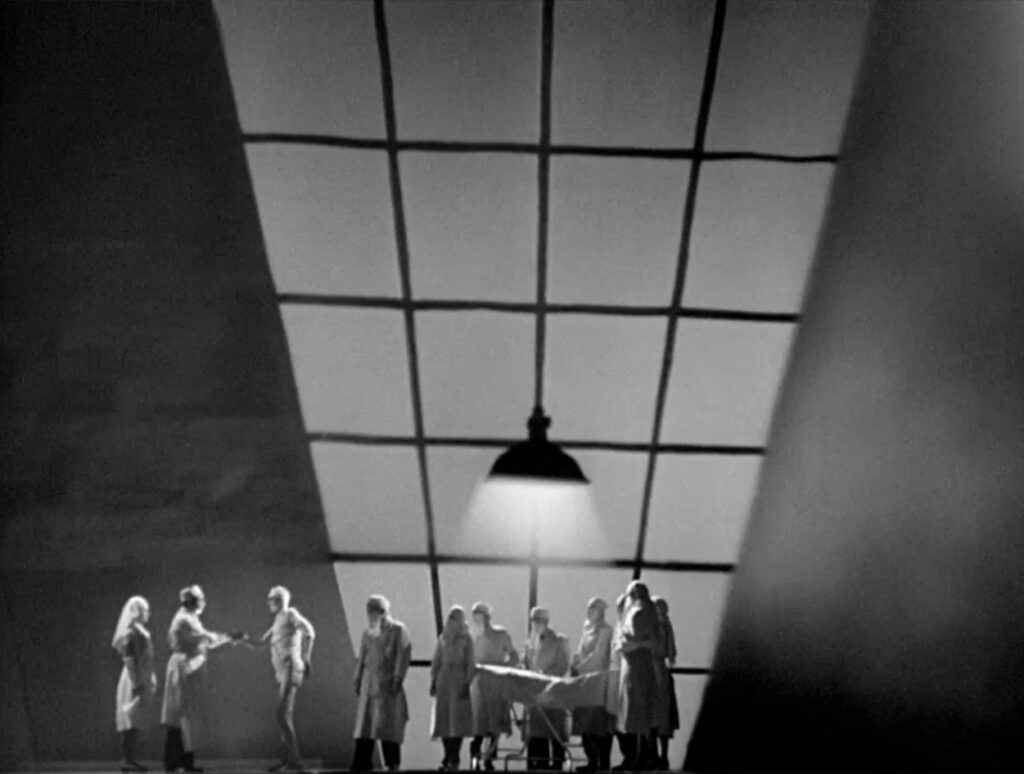
The Hand of the Devil
1943, directed by Maurice Tourneur
A sign in the Alps near the French-Italian border advertises an inn with scenic views, historic ruins, and modern comforts. An avalanche has cut the inn off from the world, and a quarrelsome medley of guests is stuck inside. The innkeeper is named Denis, like the protagonist of the 1942 pro-Resistance allegory La nuit fantastique. Saint Denis was the patron saint of the Kingdom of France, and in that film Denis had stood for the French nation… so if the innkeeper here is Denis, then the inn should be a microcosm of France. Even under Nazi Occupation, France retained its scenic landscapes, historic buildings, and some of its modern comforts, as the sign describes. The nation was cut off from the world, not by an avalanche but by invading forces, and its population was split into ideological factions like the bickering guests.
The first detail inside the inn confirms that an allegory is underway. One of the guests taps his knife impatiently on his dish in a rhythm resembling Morse Code. At least two other allegorical films of the Occupation, Lumière d’été and Voyage Without Hope, begin with similar staccato sounds that put audiences on notice that they were about to receive a coded message.
Moments later the guests hear gunshots outside, and someone asks a colonel whether he’s ever heard gunfire before, to which he replies “only at a distance”. Like Renaud in Les visiteurs du soir or La Loi in Goupi Mains Rouges, the colonel personifies the weak and indifferent French military that was so poorly prepared for the Nazi invasion that they barely saw any action before surrendering.
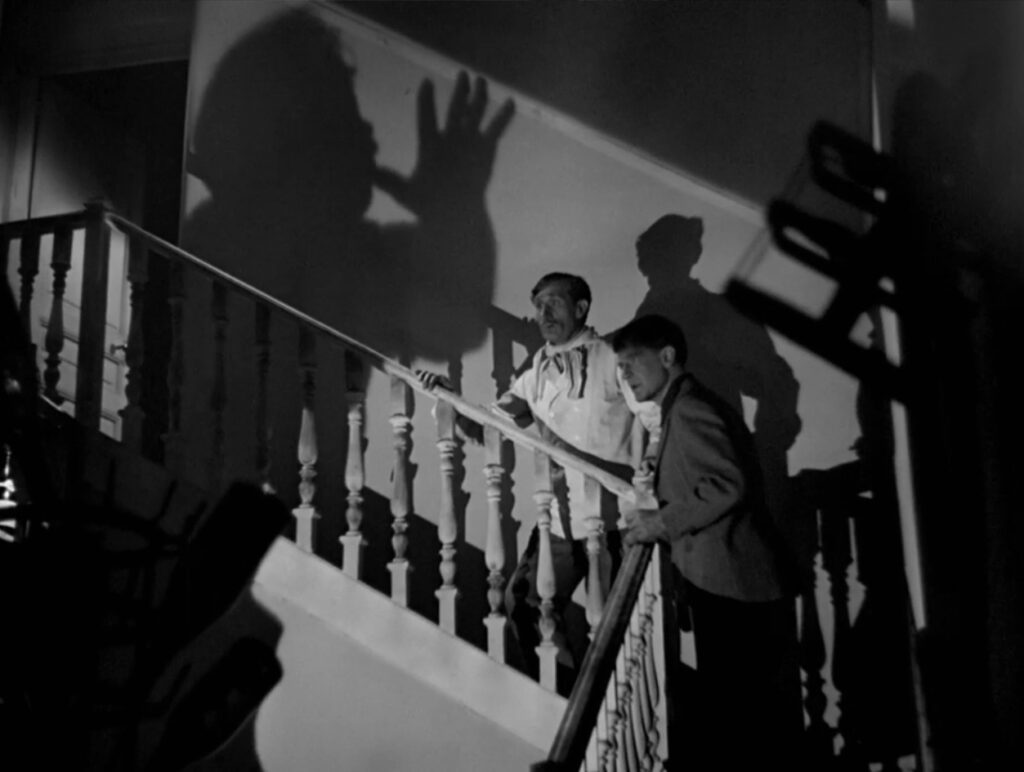
Chased into the inn by the gunshots, an artist named Roland Brissot arrives and begins telling the strange tale that will take up most of the movie. The name Roland, which appears also in Lumière d’été (also as an artist) and The Assassination of Père Noël, derives from the paladin of Charlemagne made famous in the Song of Roland. It’s a convenient name for concealing meaning from German censors because of its ambiguity – Charlemagne’s Frankish kingdom is the common ancestor to both Germany and France, making Roland a heroic figure to both nations. The name Brissot connects him to Jacques Pierre Brissot, a centrist figure who supported the French Revolution but was willing to make peace with Royalists. His surname thus mirrors and confirms the ambiguous significance of his first name.
Roland tells the inn’s guests about a woman he loved named Irène, who resisted all his overtures. “Irène was discouraging,” he says; “I hesitated over which colors to paint her, which words or acts to win her heart.” Saint Irène’s name day happens to be the occasion for two of the plot’s biggest turns, as if underscoring the importance of this woman’s name. Irène was also the name of the dream woman in La nuit fantastique; it means “peace” in Greek, and the meaning fits here too. Like most of France, Roland longs for peace, but she has only contempt for him, and he wins her hand in marriage only by making a pact with the Devil. France, in other words, by making a pact with Hitler’s Germany, had made a devil’s bargain and won only a disagreeable peace. Any sensible French person watching this in 1943 would have been reminded that the nation’s peace came at the cost of its soul and was not worth the price.
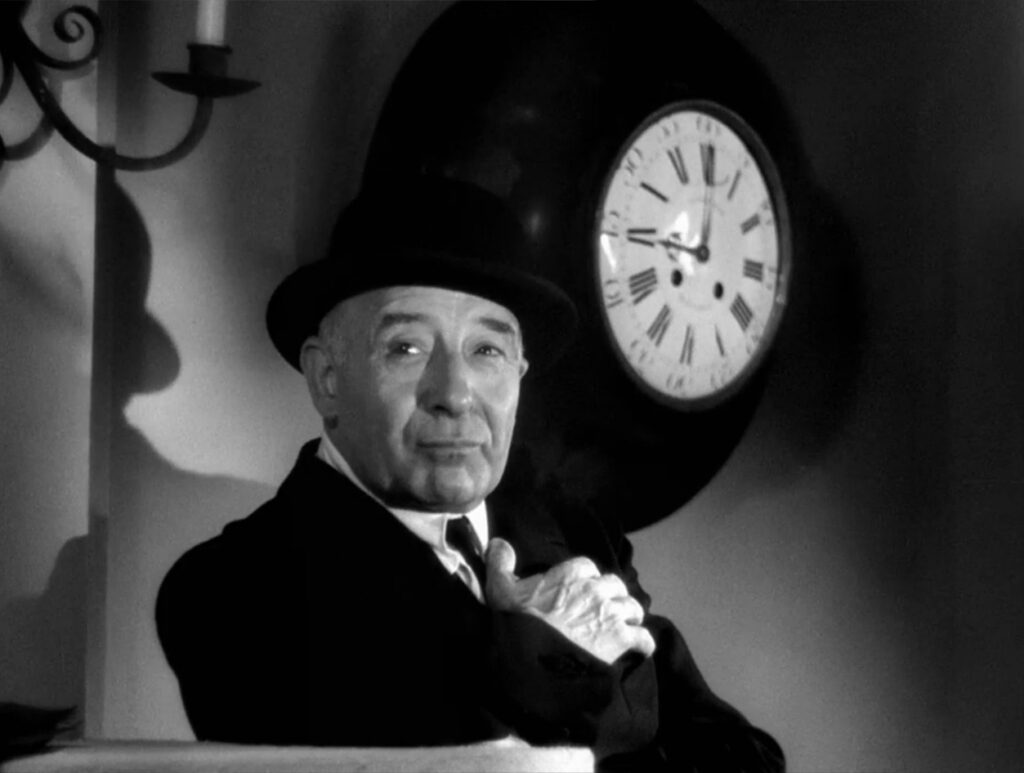
The plot does not disguise its similarity to the German legend of Faust, about a man who makes a pact with the Devil. Goethe’s play Faust is a pinnacle of German literature, so Roland Brissot’s story would have appeared non-controversial and even flattering to German censors, making it a clever mask for an anti-German twist.
Roland purchases a talisman, a severed left hand whose powers make him a famous painter and help him win Irène’s heart. The talisman though can only be sold at a loss, and now, having been sold seven times, it has reached its limit of one sous and cannot be reduced further. The Devil offers to buy it back and return his soul, but Roland still loves Irène and wants to hold onto it a bit longer – but the price of the talisman doubles every day. Roland’s predicament mirrors that of France, which must also urgently redeem itself to escape its own devil.
The character who saves Roland is the true owner of the powerful hand, Maximus Léo, which means “largest lion” in Latin. French viewers aware of the history of the Franco-Prussian War should be able to connect this with the Lion of Belfort, an enormous sandstone lion in the eastern city of Belfort symbolizing French resistance to Prussian forces in 1870-1871. The film thus tells the French people that their nation owes its soul, its talent, and its sense of duty not to Nazi Germany but to the Resistance fighters who need their help opposing the occupation.
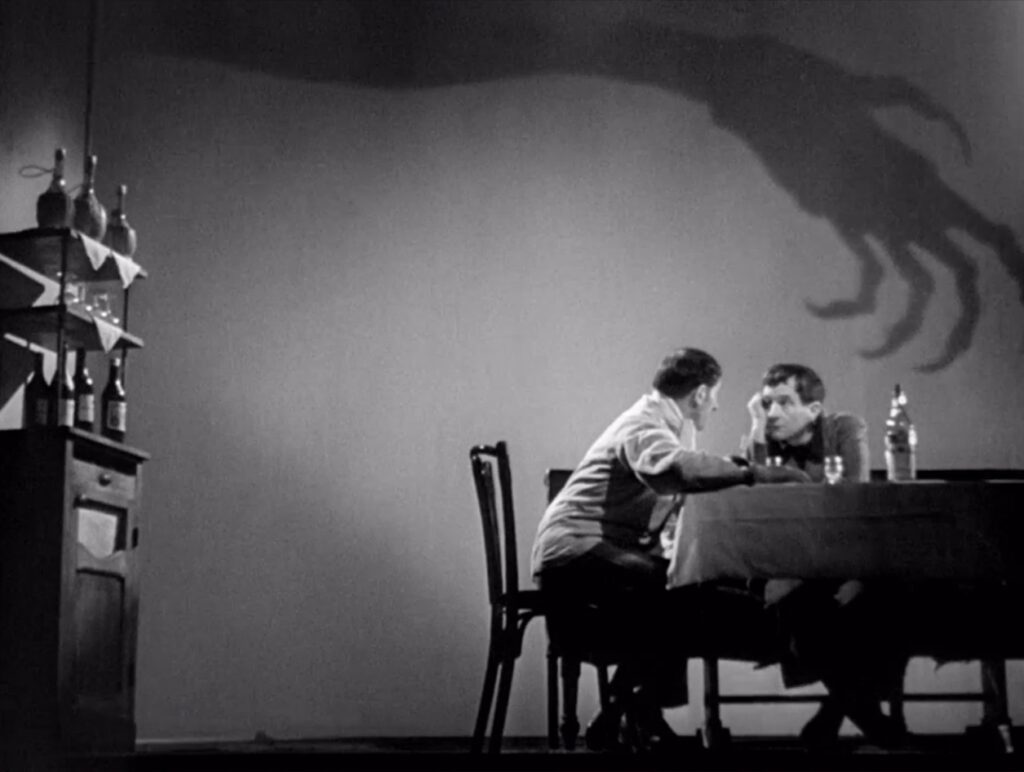
A hand represents all these things – the talent, skill, power, and duty of France. It’s the film’s first image, and it appears all over the film: the talisman that drives the plot, the glove store, the fortune teller, and the burnt print of a hand on the inn’s door. Even the name of the Palm Hotel, where Roland meets the seven masked men, refers to a hand in English though not in French. Many characters keep busy with their hands, like Irène in Mélisse’s restaurant. Three times Roland attempts to return a hand and fails: the gift of gloves to Irène, the talisman to Mélisse, and the hand of Maximus Léo on carnival night. Only at his death is he able to return the hand to its rightful owner, but France as a nation survives and witnesses his act of courage.
Although the title implies that the talisman is evil and belongs to the Devil, we find out it actually belongs to a virtuous figure who stands for the Resistance. The core of the French Resistance was formed from labor unions and the French Communist Party, so it’s natural that the talisman is therefore a left hand.
The people of France, who began the film in chaos, complaining and arguing at the inn, are unified when Roland finishes his tale. The unspoken hope is that all of France will unite behind the Resistance to overcome the invaders. The most famous scene, the chain of seven masked figures who come to Roland’s aid, expresses this call for unity. The casino operator puts it plainly: “All men are united, links in a chain. Our actions set mysterious forces in motion. If one link fails, it affects the next, and the whole system suffers.” The movie’s final line completes the message: “The last link of the chain has joined the first.”
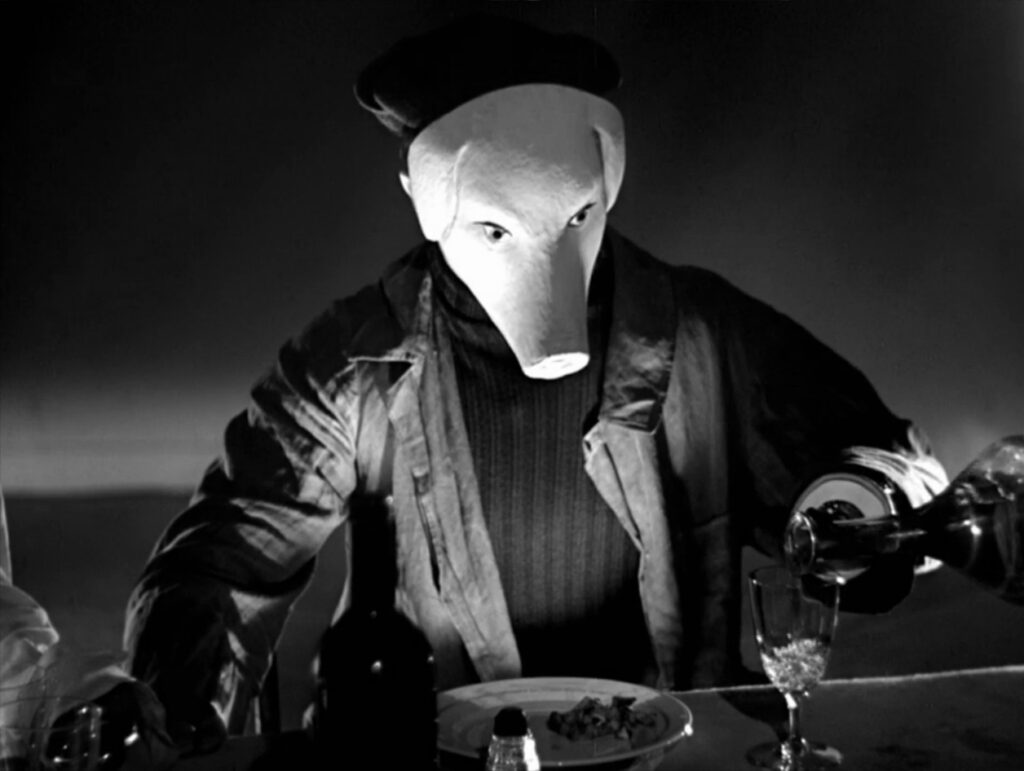
Each of the seven masked men is linked with one of the seven deadly sins, exposing the cumulative guilt that had weakened France over the years:
- The musketeer in a tiger mask who provoked and killed his best friend stands for wrath;
- The cutpurse in a feathered hat stands for greed;
- The juggler in a cat mask who threw eggs at the king and queen stands for envy;
- The magician in a mummy mask who couldn’t wake the princess he hypnotized is an inducer of sloth;
- The surgeon in a skeleton mask who tried to operate on the woman he loved stands for lust;
- The boxer in a pig mask who knocked out a referee when his sight weakened stands for pride;
- The cook in a tall hat whose roasts burned stands for gluttony.
Allusions to foreign countries fill out the story’s context. Reports of smugglers near the inn remind viewers that commerce with fascist Italy is a betrayal, and the same distrust of France’s neighbor is echoed when Roland purchases the cursed hand from Mélisse, whose accent gives him away as Italian. When the Devil appears in front of a giant painting derived from Spanish artist Francisco de Goya, a grotesque image of Saturn eating his child, the audience is reminded whose side nominally neutral Spain is really on.
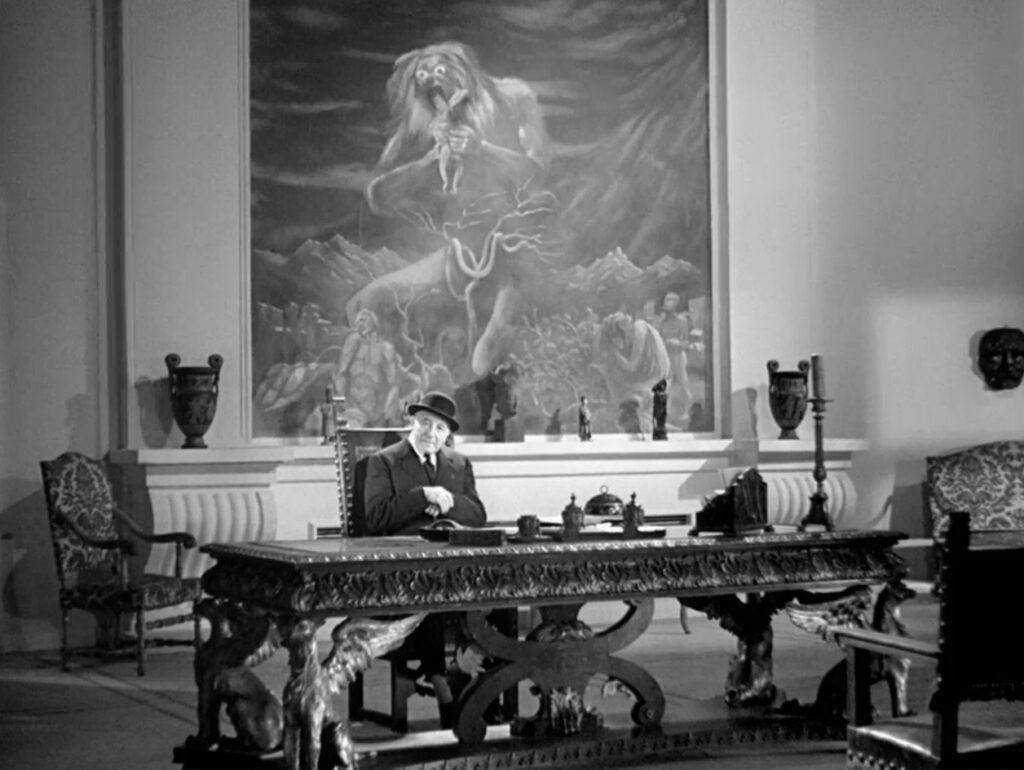
The Hand of the Devil took staggering courage to make, especially after Irène’s role went to Josseline Gaël, mistress of French Gestapo agent Antonin Saunier, whose gang was renowned for its bloodiness. She likely won her role through his influence. He was executed after the war, and she died much later in disgrace. The filmmakers must have risked their lives to use her in a role that subverted everything the Gestapo stood for.
CONNECTIONS:
Idiot’s Delight – Character named Irene who represents peace
Ladies in Retirement – Seven deadly sins linked to a group of characters
The Assassination of Père Noël – Name “Roland” used in an allegory for its dual French & German origin
La nuit fantastique – Character named Irene who represents peace, and Denis who represents France
Les visiteurs du soir – Character who stands for France’s ineffective military
Goupi Mains Rouges – Character who stands for France’s ineffective military
Lumière d’été – Opening resembling Morse Code; name “Roland” used in an allegory for its dual French & German origin
Voyage sans espoir – Opening resembling or using Morse Code
The Night of the Hunter – Image of a hand or hands alluding to the right vs. left division of the political spectrum
Andrei Rublev – Seven deadly sins as a structural device